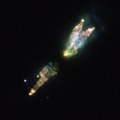Файл:Westbrook Nebula.tif — Вікіпедія

Розмір цього попереднього перегляду JPG для вихідного TIF-файлу: 600 × 600 пікселів. Інші роздільності: 240 × 240 пікселів | 480 × 480 пікселів | 1000 × 1000 пікселів.
Повна роздільність (1000 × 1000 пікселів, розмір файлу: 1,8 МБ, MIME-тип: image/tiff)
Історія файлу
Клацніть на дату/час, щоб переглянути, як тоді виглядав файл.
| Дата/час | Мініатюра | Розмір об'єкта | Користувач | Коментар | |
|---|---|---|---|---|---|
| поточний | 12:44, 9 березня 2011 |  | 1000 × 1000 (1,8 МБ) | Jmencisom | {{Information |Description ={{en|1=The strange and irregular bundle of jets and clouds in this curious image from the NASA/ESA Hubble Space Telescope is the result of a burst of activity late in the life of a star. As its core runs out of nuclear fuel, |
Використання файлу
Такі сторінки використовують цей файл:
Глобальне використання файлу
Цей файл використовують такі інші вікі:
- Використання в ar.wikipedia.org
- Використання в arz.wikipedia.org
- Використання в de.wikipedia.org
- Використання в en.wikipedia.org
- Використання в en.wikiversity.org
- Використання в fa.wikipedia.org
- Використання в fr.wikipedia.org
- Використання в it.wikipedia.org
- Використання в ja.wikipedia.org
- Використання в mk.wikipedia.org
- Використання в nl.wikipedia.org
- Використання в pl.wikipedia.org
- Використання в ru.wikipedia.org
- Використання в sk.wikipedia.org
- Використання в tr.wikipedia.org
- Використання в vi.wikipedia.org
- Використання в www.wikidata.org
- Використання в zh.wikipedia.org


 French
French Deutsch
Deutsch